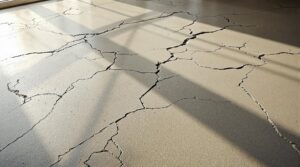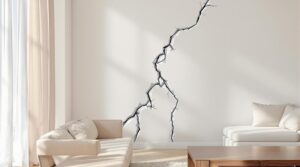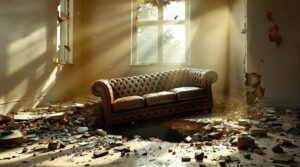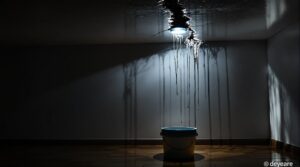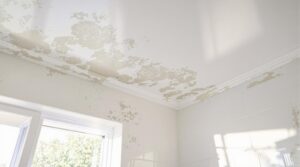Cracking noises in ceilings at night primarily result from thermal contraction as building materials cool and shrink. Wood framing can shift up to 1/8 inch per 100 degrees Fahrenheit, creating audible sounds as materials adjust. These noises become more noticeable during quiet nighttime hours when ambient sound levels decrease. Contributing factors include structural settling, changes in humidity, and HVAC system cycles. Understanding the specific cause requires examination of multiple environmental and structural elements.
Key Takeaways
- Thermal contraction of wood and building materials during nighttime cooling causes popping and cracking sounds in ceiling structures.
- Reduced ambient noise levels at night make structural sounds more noticeable when the house is quiet.
- Heating system cycles create stress on building materials, leading to distinct popping noises as surfaces expand and contract.
- Natural settling of the house and movement of framing members at connection points produce audible creaking sounds.
- Pest activity from rodents in attic spaces can create scratching and movement noises that are more noticeable at night.
Understanding Normal House Settlement Sounds
When homeowners hear cracking noises emanating from their ceilings, these sounds often stem from the natural thermal expansion and contraction of building materials. As temperatures fluctuate between day and night, building components respond to these changes by expanding or contracting, resulting in audible creaking sounds.
The phenomenon becomes particularly noticeable during nighttime hours when ambient noise levels are considerably reduced. This heightened awareness of structural sounds can lead to concerns about building integrity. However, these noises typically represent normal settling patterns, especially in wooden structures that naturally adjust to environmental conditions over time.
The cyclical nature of thermal expansion and contraction creates a pattern of movement within building materials that produces these characteristic sounds. While increased frequency of noises might warrant attention to environmental factors, these sounds generally indicate the building's natural response to temperature changes rather than structural deficiencies.
Understanding this process helps homeowners differentiate between normal settlement sounds and potentially problematic issues.
Thermal Expansion and Material Movement
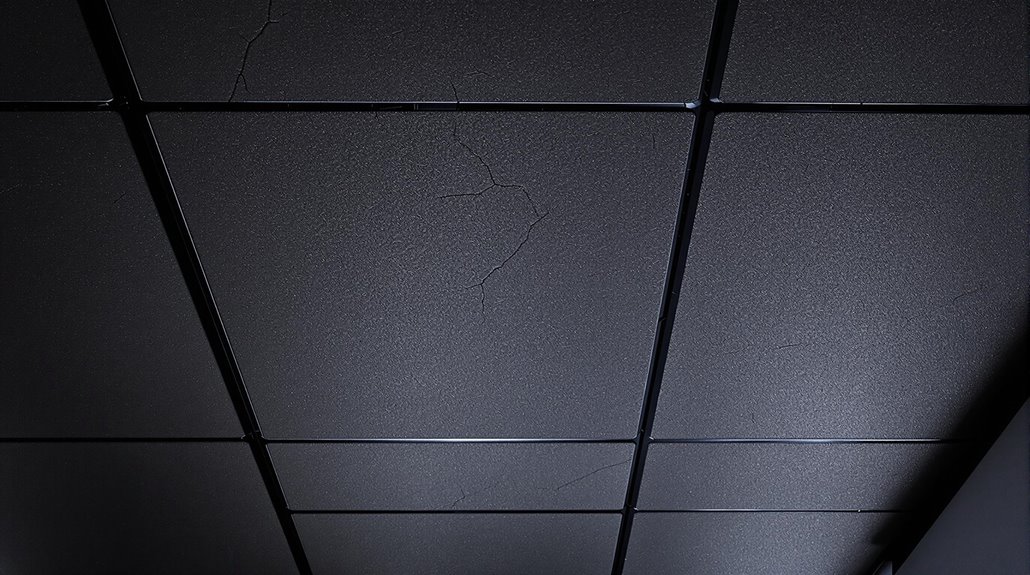
Building materials, particularly wood framing in ceiling structures, undergo constant thermal expansion and contraction as temperatures fluctuate throughout the day.
During cold periods, especially at night, these materials contract greatly, causing audible cracking sounds as the structural components adjust and shift against each other.
This daily cycle of expansion and contraction becomes more pronounced during extreme temperature changes or when heating systems cycle on and off, creating stress points within the building materials that manifest as distinct popping or cracking noises.
Temperature Effects On Wood
As temperatures fluctuate throughout the day and night, wooden ceiling structures undergo natural cycles of expansion and contraction that often manifest as cracking or popping noises. This phenomenon is particularly noticeable during nighttime hours when ambient temperatures drop and the house becomes quieter.
Wood materials can experience dimensional changes of up to 1/8 inch per 100 degrees Fahrenheit, creating tension within the structural elements.
The interaction between temperature variations and moisture content further influences this behavior. As wood absorbs humidity, it swells, while drying causes shrinkage.
These combined effects are especially pronounced in homes with regular heating cycles, where consistent temperature changes stress the wooden components.
Older homes may experience more frequent cracking sounds due to aged wood that has undergone years of thermal cycling and settlement.
Materials Contract When Cold
The physical properties of materials in residential structures follow predictable patterns of thermal expansion and contraction. When temperatures drop, particularly during nighttime hours, building materials undergo thermal contraction, causing them to shrink and create tension within the structure. This process frequently results in cracking noises as materials adjust to cooler temperatures.
Different building components, including wood beams, metal fasteners, and ceiling joists, contract at varying rates during temperature fluctuations. The differential movement between these materials creates stress points at joints and connection areas.
As materials adapt to colder temperatures, the resulting tension releases through audible sounds. This natural response to temperature changes is most pronounced in ceiling structures, where the combination of different materials and gravitational forces amplifies the acoustic effects of thermal contraction.
Daily Expansion-Contraction Cycle
Residential structures experience a continuous cycle of thermal expansion and contraction throughout each 24-hour period. As temperatures rise during daylight hours, building materials expand, while the subsequent cooling at night causes these same materials to contract. This natural cycle generates various noises and sounds as different structural components adjust to temperature changes.
The process becomes particularly noticeable following heating cycles, when the shift between expansion and contraction is most pronounced.
Both wooden elements and metal components within the ceiling structure respond to these temperature fluctuations at different rates. The interaction between materials, combined with varying humidity levels, creates the characteristic cracking and popping sounds that are commonly heard.
These acoustic effects are typically more perceptible during nighttime hours when ambient noise levels are lower.
The Impact of Weather Changes on Your Home

Weather fluctuations substantially influence structural components within homes, causing various materials to undergo physical changes throughout daily temperature cycles. As temperatures shift, building materials like wood and metal experience thermal expansion and contraction, resulting in audible cracking noises, particularly in ceiling structures.
These weather changes affect homes through multiple mechanisms. The most direct impact occurs through temperature differentials between day and night, with cooler nighttime temperatures intensifying the contraction of materials.
Additionally, varying soil moisture levels caused by weather patterns can affect foundation stability, potentially contributing to structural stress and subsequent noise generation.
Insufficient insulation compounds these effects by allowing greater temperature variations within the structure.
Professional assessment of insulation quality and regular maintenance of roofing systems can help minimize the impact of weather-related expansion and contraction, thereby reducing the frequency and intensity of structural noises throughout the home.
Regular risk assessments with insurance professionals can help identify potential structural vulnerabilities that may require additional coverage.
Common Structural Causes of Ceiling Noises
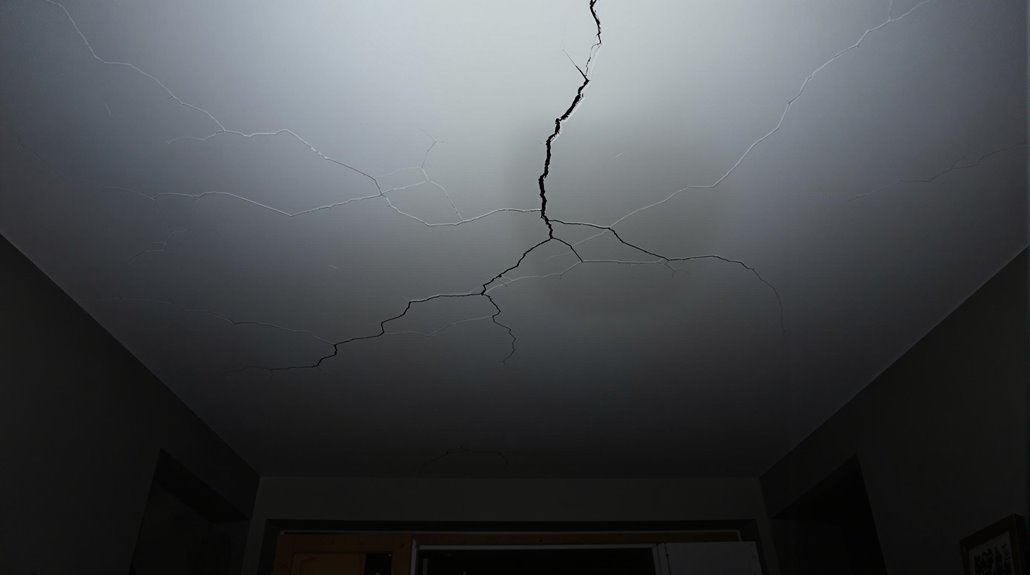
Building structures commonly exhibit various noise-generating mechanisms that stem from their fundamental design and construction elements.
The structural framework of a house, particularly in ceiling areas, can produce distinct sounds coming from multiple sources related to its physical composition and assembly methods.
Improperly installed framing members and fasteners represent a significant source of ceiling noise, as these components may shift and adjust under varying loads.
The connection points between different structural elements are especially prone to movement, creating audible creaking or cracking sounds.
Additionally, roofing materials undergo constant stress from environmental factors, leading to settlement and warping that transfer sounds through the ceiling structure.
Long-term structural stresses, including building settlement and lateral forces, can gradually affect the integrity of ceiling components.
These ongoing pressures may manifest as recurring noises, potentially indicating the need for professional evaluation of the building's structural condition.
Identifying Pest-Related Disturbances
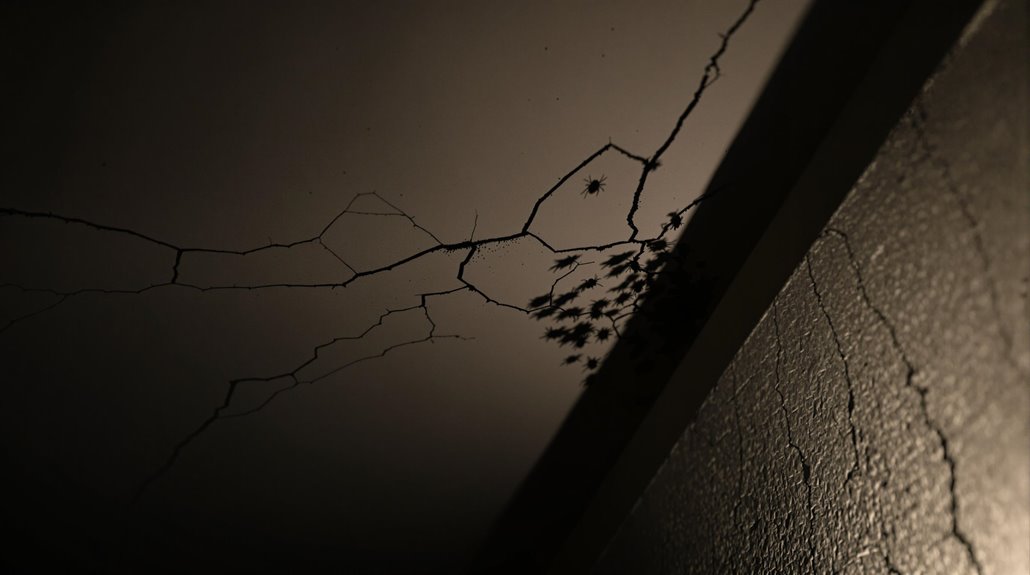
Rodents typically access ceiling spaces through small gaps around utility penetrations, gaps in soffits, and deteriorated areas along rooflines, creating pathways for ongoing infestations.
The movement patterns of mice and other pests generate distinct scratching and scurrying sounds that often follow linear paths along joists and become more frequent during nighttime hours.
Evidence of nesting activity includes shredded insulation, scattered droppings, and gnaw marks on wooden structural elements, which help confirm the presence of pest-related disturbances.
Common Pest Entry Points
When investigating ceiling noises, identifying potential pest entry points becomes essential for determining whether unwanted visitors are the source of disturbances.
Common pest entry points include gaps surrounding windows and doors, foundation cracks, and openings for utility lines. Small spaces that may seem insignificant can provide adequate access for rodents and insects.
In older homes, roof vents, chimneys, and attic openings are particularly vulnerable areas where seals may have deteriorated over time.
Damaged or missing siding on exterior walls can create additional access points for pests seeking shelter. Noises are usually more prevalent near these entry locations, making their identification vital for addressing the root cause.
Installing screens on vents and sealing crevices, combined with regular inspections, can effectively minimize pest-related disturbances and maintain structural integrity.
Pest Movement Sound Patterns
Distinguishing pest-related noises from other ceiling disturbances requires an understanding of specific sound patterns and timing characteristics. When noise is coming from the ceiling during nighttime hours, rodent activity often manifests as distinct patterns that differ from typical house popping noises. The frequency and nature of these sounds can provide vital identification clues.
| Sound Type | Pest Indication |
|---|---|
| Scratching | Active movement across surfaces |
| Light Thumps | Jumping or dropping movements |
| Quick Darting | Rapid traversal between spaces |
Nocturnal pest movements typically peak during quiet hours, making them more noticeable to occupants. These sounds often follow predictable pathways as rodents travel between nesting sites and food sources. Professional inspection can confirm pest presence by correlating acoustic patterns with physical evidence such as droppings or entry points.
Signs Of Nesting Activity
Identifying signs of pest nesting activity requires systematic observation of both auditory and physical evidence within ceiling spaces.
When noises coming from overhead suggest potential rodent presence, thorough investigation of the attic space becomes essential for confirmation. Professional assessment can determine whether scratching, tapping, or scurrying sounds indicate active infestations requiring intervention.
Key indicators of pest nesting activity include:
- Distinct scratching or movement sounds during nighttime hours when ambient noise levels decrease
- Visual evidence of droppings or gnaw marks along ceiling joists and structural elements
- Disrupted insulation materials or gathered nesting debris in corners or cavities
- Entry points near utility penetrations or structural gaps that allow access to ceiling spaces
These signs, when properly documented, enable pest control specialists to develop targeted remediation strategies for effective infestation management.
HVAC Systems and Ductwork Sounds
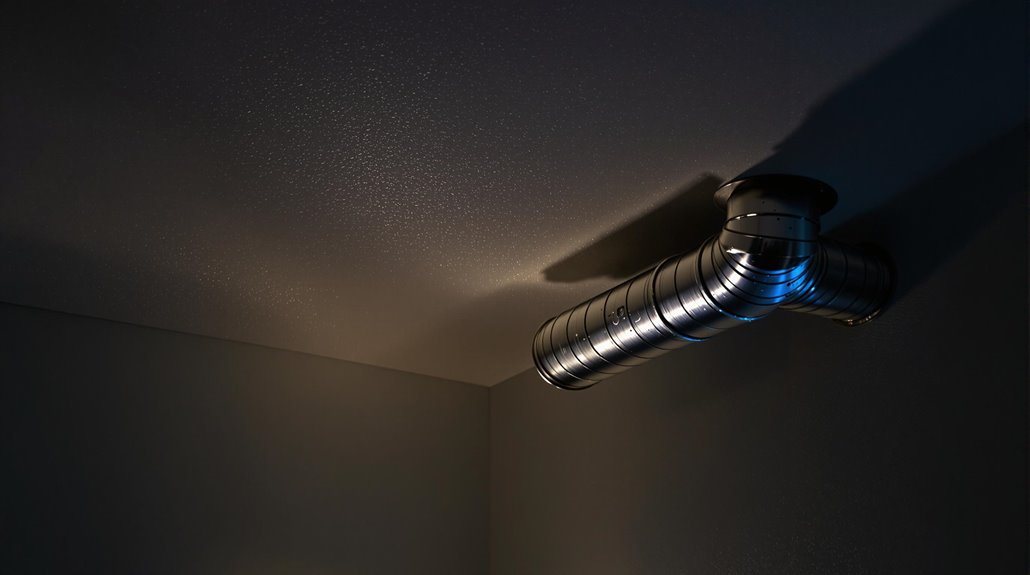
Many homeowners experience mysterious cracking sounds emanating from their ceilings due to HVAC system operations. These sounds typically occur when heating or cooling cycles cause temperature fluctuations in the ductwork, leading to expansion and contraction of metal components. The resulting sound can manifest as distinct cracking or tapping noises throughout the system.
The interaction between ductwork and mounting brackets frequently generates these disruptive sounds, particularly when air pressure changes within the system. Inadequate insulation surrounding the ductwork intensifies this effect, as greater temperature differentials between the internal airflow and external environment amplify the noise production.
Additionally, improper installation or loosely secured ductwork components can create excessive vibration, which becomes more noticeable during quiet nighttime periods.
Professional HVAC maintenance can identify potential noise sources through systematic inspection of the system's components, ensuring proper insulation, secure mounting, and peak performance of the entire ductwork network.
Plumbing and Pipe-Related Noises
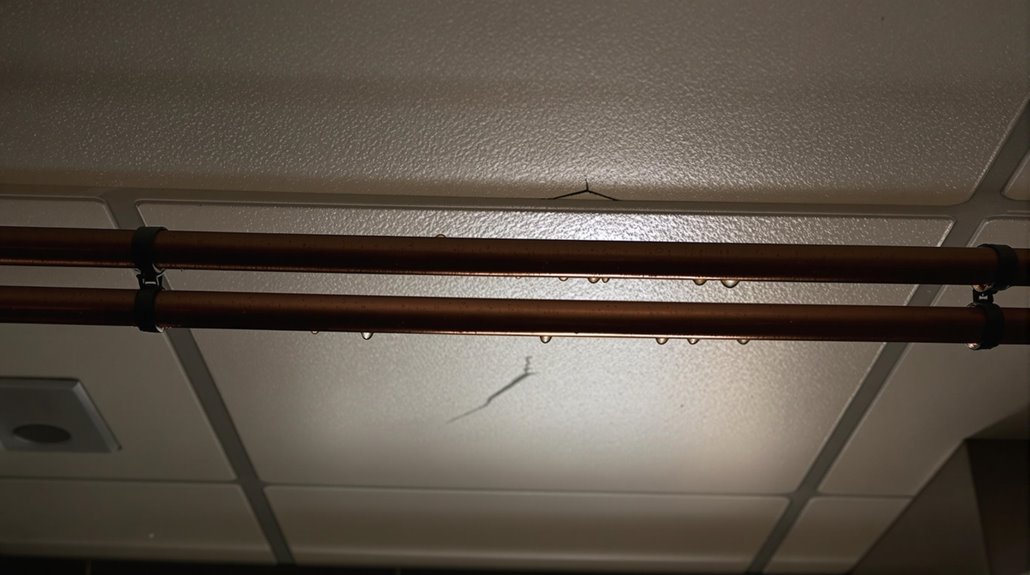
While plumbing systems remain hidden within ceiling cavities, they frequently generate distinct cracking and popping sounds due to thermal expansion and contraction of pipes.
These strange sounds typically occur when water temperature changes throughout the day, causing metal and plastic components to react differently to thermal stress.
When the sound is coming from above, it may originate from various plumbing components, though the source might actually be located on lower floors.
Common factors contributing to plumbing-related ceiling noises include:
- Metal pipes expanding and contracting more dramatically than modern plastic alternatives, especially in older homes
- Improperly secured plastic clips and fasteners that allow excessive pipe movement
- Poorly fitted pipe supports that create friction points during thermal changes
- Radiator systems mounted with insufficient or overtightened plastic clips
The intensity of these noises often varies with the material type, installation quality, and the temperature differential between the pipe contents and surrounding environment.
Preventative Maintenance Solutions

Proactive maintenance serves as the cornerstone for minimizing and preventing ceiling cracking noises in residential structures.
Regular attic inspections enable early detection of moisture issues and pest infestations that could compromise structural integrity. Proper insulation management plays an important role in stabilizing temperature fluctuations that cause material expansion and contraction.
Implementing preventative maintenance solutions requires a systematic approach. Maintaining consistent indoor temperatures during cold periods reduces thermal stress on building materials.
Reinforcing drywall connections and structural joints through re-screwing or additional support helps minimize movement-related noises.
Annual professional inspections of both roofing and foundation components are essential for identifying potential issues before they manifest as problematic ceiling sounds.
For thorough assessment and implementation of these preventative measures, contact us to schedule an inspection with certified professionals who can evaluate your specific situation and recommend targeted solutions for long-term noise reduction.
When to Call a Professional Inspector
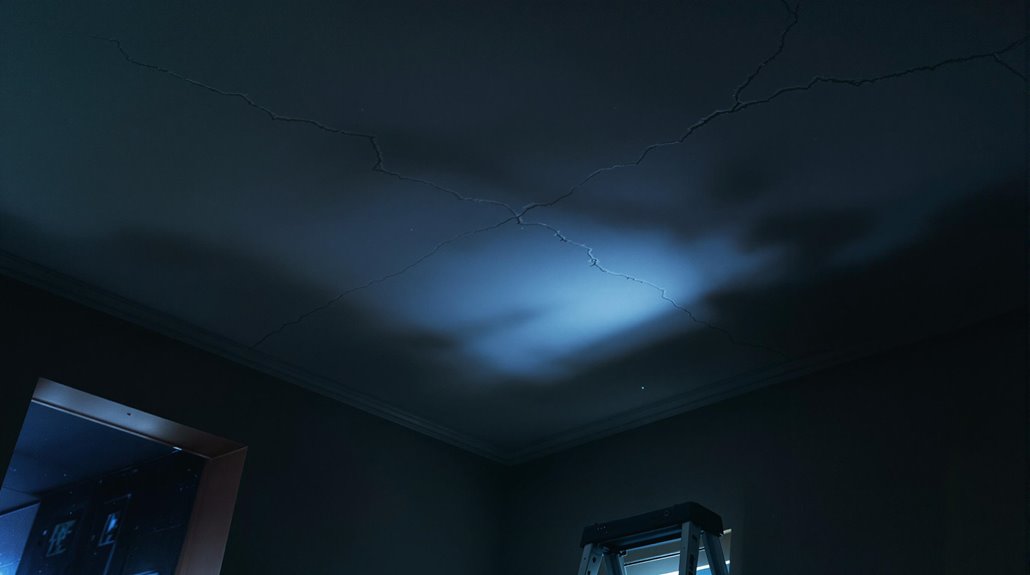
Identifying the right moment to engage a professional inspector requires careful observation of specific warning signs in ceiling acoustics and structural behavior.
When cracking noises persist and intensify over time, particularly in conjunction with visible structural changes, immediate professional intervention becomes necessary to assess potential foundation issues.
Key indicators that warrant a professional inspection include:
- Cracking noises that increase in frequency and intensity, especially when accompanied by visible ceiling damage.
- Wall or ceiling cracks exceeding quarter-inch width, indicating potential structural compromise.
- Persistent nighttime sounds that correlate with temperature fluctuations and disrupt sleep patterns.
- Combined occurrence of ceiling noises with door and window alignment issues.
These symptoms may signify underlying structural problems, from foundation settlement to thermal expansion concerns.
Additionally, if there's any indication of pest activity contributing to the noises, a professional inspection becomes vital to prevent escalating structural damage and maintain building integrity.
Frequently Asked Questions
Why Does My Ceiling Make a Crackling Sound at Night?
Ceiling noises commonly occur due to thermal expansion and contraction of building materials, primarily wood and metal components.
As temperatures decrease during nighttime hours, these materials respond by contracting, creating distinctive night sounds. The phenomenon intensifies when ambient temperatures drop considerably, causing structural elements to adjust and settle.
Additionally, fluctuations in humidity levels affect wood fibers, contributing to the crackling acoustic manifestations in residential structures.
Why Does My House Make Loud Cracking Noises at Night?
Studies show that residential buildings can experience up to 1/4 inch of thermal movement daily.
Loud cracking house noises typically occur at night due to thermal expansion and contraction of building materials. Common causes include temperature fluctuations between day and night, which force materials like wood framing, metal fasteners, and drywall to adjust. These adjustments can create sounds that may seem alarming, but they are generally a normal part of a house settling. If you experience persistent or alarming noises, it’s essential to investigate further, as they could indicate underlying issues. Understanding walls cracking causes and solutions can help homeowners address any concerns and ensure their home remains safe and sound.
The HVAC system's cycling can also trigger these sounds through ductwork movement and pressure changes.
Why Does My Ceiling Make a Random Clicking Sound?
Random clicking sounds in ceiling acoustics typically result from thermal expansion and contraction of building materials.
As temperatures fluctuate, structural components adjust, creating distinct noise patterns. Common causes include wooden framing members shifting, HVAC ductwork movement, and plumbing pipe expansion.
These sounds often intensify during temperature changes and may be more noticeable in quieter environments.
Poorly secured building components can amplify these acoustic phenomena.
How to Stop Cracking Noises in the Ceiling?
Like a skilled conductor silencing an unwanted symphony, stopping ceiling noises requires strategic intervention.
Effective noise reduction methods include applying expanding foam insulation between joists, securing loose fasteners in the ceiling structure, and installing additional bracing supports.
Professional ceiling repairs may involve addressing thermal expansion issues through consistent climate control and conducting thorough inspections of the roofing system to identify structural weaknesses requiring maintenance. Additionally, homeowners must be proactive in their approach to preventing further damage by understanding how to fix ceiling plaster cracks, which can arise from the stress caused by temperature fluctuations. Regular maintenance and timely repairs can prolong the lifespan of the ceiling and ensure a safe, aesthetically pleasing environment. It is also advisable to consult with a roofing professional who can assess and recommend solutions tailored to the specific conditions of your home.
Final Thoughts
Ceiling noises, while unsettling, stem from multiple identifiable sources that require systematic investigation. From thermal expansion and structural settling to HVAC operations and pest activity, each distinct sound provides essential diagnostic information. Through proper maintenance protocols, regular inspections, and professional intervention when necessary, homeowners can effectively address these acoustic disturbances, ensuring both structural integrity and peace of mind throughout their residence.
For homeowners experiencing property damage related to ceiling issues, insurance industry professionals and legal experts strongly advise consulting a qualified state-licensed public adjuster for insurance claims. Public adjusters work exclusively as policyholder advocates, not for insurance companies. These state-licensed professionals help policyholders navigate complex insurance policies, identify hidden damages often unknown to be covered, document losses comprehensively, and negotiate with insurance companies to secure fair settlements while protecting policyholder rights.
The benefits of hiring a public adjuster include maximized claim payouts, expedited claim processing, and reduced stress when dealing with insurance companies. Policyholders seeking expert guidance on property damage or loss claims can request a no-obligation free consultation with a Public Claims Adjusters Network (PCAN) member public adjuster through their contact page.


